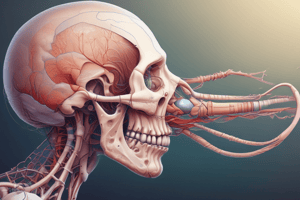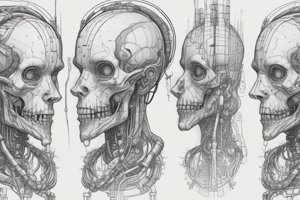Podcast
Questions and Answers
What is the result when fertilization does not occur?
What is the result when fertilization does not occur?
- The uterine tube expands
- The ovary stops functioning
- Fertilization occurs in the cervix
- The egg degenerates, and menstruation occurs (correct)
Where does the process of fertilization occur?
Where does the process of fertilization occur?
- In the ampullary region of the uterine tube (correct)
- In the cervix
- In the ovary
- In the uterus
What is the purpose of capacitation?
What is the purpose of capacitation?
- To prevent the acrosome reaction
- To condition the sperm to penetrate the corona cells (correct)
- To inhibit fertilization
- To facilitate fertilization
What triggers the acrosome reaction?
What triggers the acrosome reaction?
What is the function of the acrosome reaction?
What is the function of the acrosome reaction?
What is the purpose of Phase I of fertilization?
What is the purpose of Phase I of fertilization?
What is the function of the zona pellucida?
What is the function of the zona pellucida?
What happens to the permeability of the zona pellucida during fertilization?
What happens to the permeability of the zona pellucida during fertilization?
What is the purpose of the acrosome reaction?
What is the purpose of the acrosome reaction?
What is the result of the fusion of the sperm and oocyte membranes?
What is the result of the fusion of the sperm and oocyte membranes?
What happens to the cells during cleavage?
What happens to the cells during cleavage?
What is the name of the cluster of cells that forms after four initial cell divisions?
What is the name of the cluster of cells that forms after four initial cell divisions?
What is the term for the process of rapid cell divisions after fertilization?
What is the term for the process of rapid cell divisions after fertilization?
What is the term for the cells that derive from cleavage up to the blastula stage?
What is the term for the cells that derive from cleavage up to the blastula stage?
What is the term for all structures that develop from the zygote, both embryonic and extraembryonic?
What is the term for all structures that develop from the zygote, both embryonic and extraembryonic?
What is the branch of biology that studies the development of gametes, fertilization, and development of embryos and fetuses?
What is the branch of biology that studies the development of gametes, fertilization, and development of embryos and fetuses?
What is the result of the zona reaction?
What is the result of the zona reaction?
At what stage of development is the embryo termed a fetus?
At what stage of development is the embryo termed a fetus?
What is the duration of the normal period of gestation?
What is the duration of the normal period of gestation?
What is the term for the study of congenital disorders that occur before birth?
What is the term for the study of congenital disorders that occur before birth?
During which week of development does the concept shift from a single-celled zygote into a multi-leveled, multi-dimensional fetal body plan?
During which week of development does the concept shift from a single-celled zygote into a multi-leveled, multi-dimensional fetal body plan?
What is the term for the process by which the fertilized egg develops into an embryo?
What is the term for the process by which the fertilized egg develops into an embryo?
What is the process that occurs after fertilization, resulting in the formation of a multicellular embryo?
What is the process that occurs after fertilization, resulting in the formation of a multicellular embryo?
What is the term for the stage of development during which the embryo has more recognizable external features and a more complete set of developing organs?
What is the term for the stage of development during which the embryo has more recognizable external features and a more complete set of developing organs?
What is the term used to describe the solid sphere of cells within the zona pellucida?
What is the term used to describe the solid sphere of cells within the zona pellucida?
What is the primary function of the trophoblast layer?
What is the primary function of the trophoblast layer?
What is the term used to describe the process of the blastocyst burrowing into the endometrium?
What is the term used to describe the process of the blastocyst burrowing into the endometrium?
What is the first cavity formed during embryonic development?
What is the first cavity formed during embryonic development?
When does implantation typically occur?
When does implantation typically occur?
What is the term used to describe the stage of embryonic development where fluids penetrate the zona pellucida?
What is the term used to describe the stage of embryonic development where fluids penetrate the zona pellucida?
What is the primary function of the corpus luteum after ovulation?
What is the primary function of the corpus luteum after ovulation?
What is the term for the cluster of cells that surround the oocyte in the ovarian follicle and after ovulation?
What is the term for the cluster of cells that surround the oocyte in the ovarian follicle and after ovulation?
What is the result of the LH surge in the ovulation process?
What is the result of the LH surge in the ovulation process?
What is the purpose of the fimbriae of the uterine tube?
What is the purpose of the fimbriae of the uterine tube?
What happens to the endometrium if fertilization does not occur?
What happens to the endometrium if fertilization does not occur?
What is the term for the structure that forms from the ruptured follicle after ovulation?
What is the term for the structure that forms from the ruptured follicle after ovulation?
What is the result of the failure of the blastocyst to implant within the endometrium?
What is the result of the failure of the blastocyst to implant within the endometrium?
What is the term for the layer of cells that surrounds the oocyte after ovulation?
What is the term for the layer of cells that surrounds the oocyte after ovulation?
Flashcards are hidden until you start studying
Study Notes
Embryology
- Human embryogenesis is the process by which a fertilized egg develops into an embryo, studying the development of gametes, fertilization, and development of embryos and fetuses.
- Human embryology specifically studies development during the first eight weeks after fertilization.
Gamete Approximation and Fertilization
- Ovulation is the process by which a mature egg is released from the ovary, triggered by a surge of luteinizing hormone (LH).
- The released egg is covered by the zona pellucida and one or more layers of follicular cells.
- Fertilization occurs in the ampullary region of the uterine tube, involving capacitation, the acrosome reaction, and penetration of the corona radiata and zona pellucida.
Capacitation and Acrosome Reaction
- Capacitation is a period of conditioning in the female reproductive tract, allowing sperm to pass through corona cells and undergo the acrosome reaction.
- The acrosome reaction, induced by zona proteins, releases enzymes needed to penetrate the zona pellucida.
Phases of Fertilization
- Phase I: Capacitated sperm pass through the corona radiata.
- Phase II: Sperm penetrate the zona pellucida, releasing acrosomal enzymes.
- Phase III: Fusion of oocyte and sperm cell membranes occurs.
Results of Fertilization
- Restoration of the diploid number of chromosomes occurs, with half from the father and half from the mother.
- The sex of the new individual is determined, with an X-carrying sperm producing a female embryo and a Y-carrying sperm producing a male embryo.
- Initiation of cleavage occurs, resulting in rapid cell divisions with no significant growth.
Cleavage and Morula Formation
- Cleavage results in a cluster of cells called the morula, with at least four initial cell divisions producing a dense ball of at least sixteen cells.
- The morula forms within four days as it travels to the uterine cavity.
Blastulation (Blastocyst Formation)
- The morula develops into a blastocyst, consisting of an inner cell mass (ICM) and an outer layer of cells called the trophoblast.
- The blastocoel is a fluid-filled cavity formed within the blastocyst.
Implantation
- Implantation is a complex biochemical and mechanical process that begins in the first week of gestation and extends into the second week.
- The process involves apposition, attachment, and invasion of the blastocyst into the uterine wall.
Studying That Suits You
Use AI to generate personalized quizzes and flashcards to suit your learning preferences.



